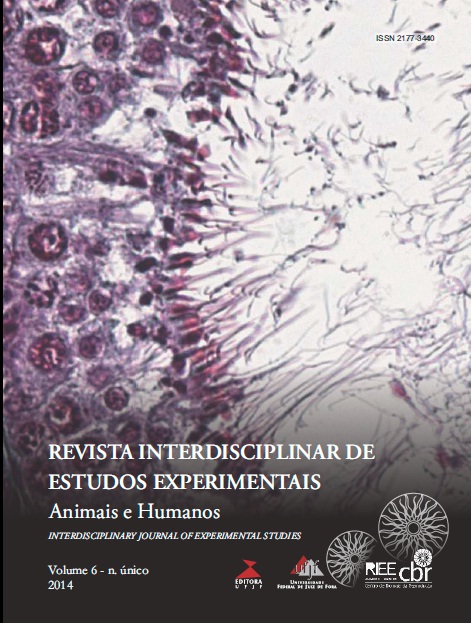Efeito do Extrato de Ginkgobiloba (EGb) sobre a toxicidade sistêmica e órgãos do sistema reprodutor masculino de ratos Wistar adultos
Palavras-chave:
Ginkgobiloba, ratos, toxicidade, fitoterapia.Resumo
O Extrato de Ginkgobiloba (EGb) é um dos fitoterápicos mais consumidos no mundo. Entretanto ainda há escassez de ensaios toxicológicos em animais e o risco à exposição humana principalmente pelos compostos alquilfenóis, representados pelos ácidos ginkgólicos, que podem causar quadros alérgicos e serem compostos mutagênicos e carcinogênicos. O presente trabalho teve o objetivo de avaliar a toxicidade sistêmica do EGb. Oitenta ratos Wistar de três meses de idade foram tratados com água destilada (Grupo Controle) e extrato aquoso de Ginkgobilobanas seguintes doses: 3,5 (EGb 3,5); 7,0 (EGb 7,0) e 14,0mg/kg (EGb 14,0) uma vez ao dia, por 56 dias consecutivos. Foram avaliados semanalmente, o peso dos animais (g) e a estimativa de consumo diário de ração (g). Indícios de sinais de toxicidade sistêmica como perda de peso, piloereção, diarreia, cromodacriorreia, estereotipias, alterações da atividade locomotora e comportamentais e mortes também foram monitorados. Após anestesia, o sangue dos animais foi coletado para avaliação de hemograma completo e dosagem bioquímica de ureia, creatinina e alanina aminotransferase (ALT). Após a eutanásia, os animais foram submetidos à necropsia e os testículos esquerdo e direito, epidídimo esquerdo, vesícula seminal repleta, próstata ventral, rins esquerdo e direito, fígado e baço foram removidos e pesados em balança de precisão. Durante todo o procedimento experimental não foram observados nos animais sinais clínicos de toxicidade sistêmica e mortes. Houve diferenças estatísticas da estimativa de consumo de ração na sexta semana e oitava semanas de avaliação, embora sem diferença no peso corporal. Não houve diferença no peso dos órgãos e na análise bioquímica sérica. Na avaliação hematológica dos animais, houve diferença estatística significativa na hemoglobinometria em que o grupo EGb 14,0 apresentou-se estatisticamente superior ao grupo EGb 3,5.A concentração de hemoglobina globular média também apresentou diferença estatística significativa, em que o EGb 3,5 apresentou médias inferiores aos grupos EGb 7,0 e EGb 14,0 e o grupo controle apresentou média inferior ao grupo EGb 14,0. Sugere-se que o EGb no presente trabalho, e com as doses utilizadas, não causou toxicidade sistêmica e nem provocou alterações em órgãos de ratos Wistar.
Downloads
Downloads
Publicado
Edição
Seção
Licença
Autores que publicam nesta revista concordam com os seguintes termos:- Autores mantém os direitos autorais e concedem à revista o direito de primeira publicação, com o trabalho simultaneamente licenciado sob a Creative Commons Attribution License que permitindo o compartilhamento do trabalho com reconhecimento da autoria do trabalho e publicação inicial nesta revista.
- Autores têm permissão e são estimulados a citar e distribuir seu trabalho (ex.: em repositórios institucionais, página pessoal, trabalhos científicos, etc) desde que citada a fonte (referência), já que isso pode gerar produtividade para os autores, bem como aumentar o impacto e a citação do trabalho publicado.

